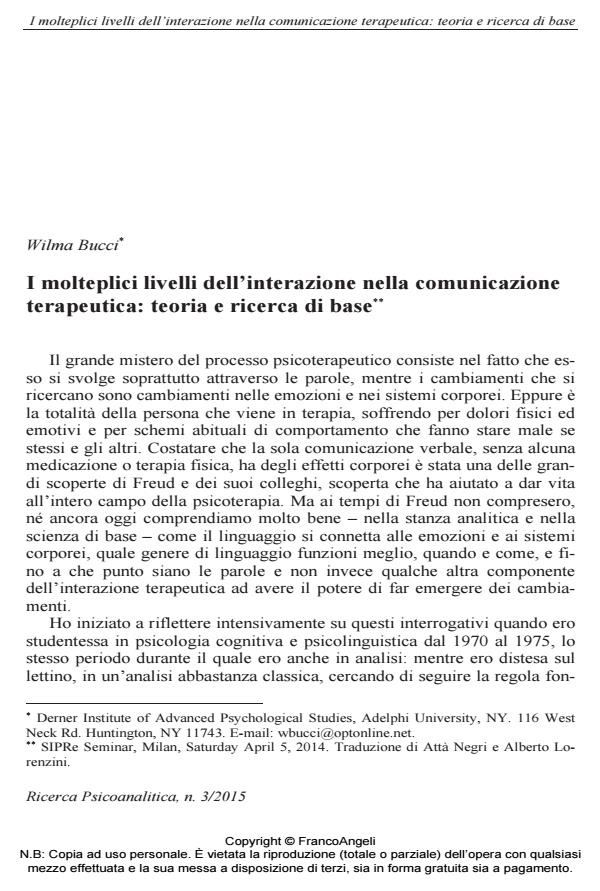Multiple levels of interaction in therapeutic communication. Theory and basic research
Journal title RICERCA PSICOANALITICA
Author/s Wilma Bucci
Publishing Year 2015 Issue 2015/3
Language Italian Pages 16 P. 9-24 File size 87 KB
DOI 10.3280/RPR2015-003002
DOI is like a bar code for intellectual property: to have more infomation
click here
Below, you can see the article first page
If you want to buy this article in PDF format, you can do it, following the instructions to buy download credits

FrancoAngeli is member of Publishers International Linking Association, Inc (PILA), a not-for-profit association which run the CrossRef service enabling links to and from online scholarly content.
Starting from a description of the personal experience that prompted her to develop her model the Author presents the cornerstones of her multiple code theory, revised and updated with the most recent findings from cognitive sciences and psychotherapeutic models field. The qualities characterizing the three main levels of the human emotional information processing - sub-symbolic, symbolic non-verbal, symbolic verbal - and the multiple modality specific codes through which is experienced the interaction with the world are described. Within this new theory of mind crucial clinical concepts and processes are defined as the emotion schemas, the typical interactive sequences from which they emerge and their reactivation in the therapeutic communication, the interactive and internal processes that conduct to the persistence of the painful emotion schemas or to the continuous modification of those promoting the subject’s wellbeing. Finally, the Author describes the referential process that connects the various levels of emotional information processing in the everyday contexts as well as during psychotherapy, where circularly three typical phases follow one other - activation, symbolization and reorganization/ reflection. The Author concludes by highlighting the eminently embodied and relational nature of this process, as well as its risks and paradoxes.
Keywords: Multiple code theory, referential process, emotion schema, embodied communication, emotion change
- Il processo referenziale: cognizione o coscienza incarnata? Alberto Lorenzini, in RICERCA PSICOANALITICA 3/2015 pp.67
DOI: 10.3280/RPR2015-003006 - L’apporto dei gruppi a mediazione nella clinica contemporanea. Il metodo Photolangage® Alessandra Micheloni, in Ricerca Psicoanalitica /2022
DOI: 10.4081/rp.2022.644 - Relation between referential and reflexive processes: an explorative study Giovanna Esposito, Livia Savarese, Barbara Squitieri, in Counselling Psychology Quarterly /2019 pp.186
DOI: 10.1080/09515070.2018.1428528 - Commento al caso clinico di A. Micheloni Giuseppe Martorana, in Ricerca Psicoanalitica /2021
DOI: 10.4081/rp.2021.536
Wilma Bucci, I molteplici livelli dell’interazione nella comunicazione terapeutica: teoria e ricerca di base in "RICERCA PSICOANALITICA" 3/2015, pp 9-24, DOI: 10.3280/RPR2015-003002